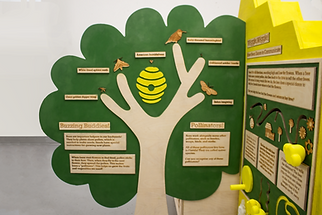Bee Interactive Exhibit for Children

This interactive exhibit was a year long project aiming to introduce children, aged three to five, to the world of bees.
This exhibit was invited to showcase at a Nature Day event at local community: Sarasota Landings. It is now permanently installed at a primary school called The Classical Academy of Sarasota. It also won the Faculty Award from Ringling College of Art and Design in their Best of Ringling 2025 showcase.



Early Ideation Sketch
Interactives Ideation
Final Ideation Sketch




Model_V3
Model_V5
Model_V7
Color test
The exhibit went through a total of seven versions; all 3D modeled in Fusion 360. It improved with mentor guidance and adaptions to its overall shape appeal, reduction of the interactive complexity, and physical stability.

4'x8' plywood sheet in the woodshop

CNC'ed shapes waiting in the studio

CNC router cutting the tree



Hand router repair
Booth assembly
Main wall assembly



Roof section assembly
Laser cutting
In-progress photo

Waxing all unpainted elements with beeswax

Painting back of exhibit with milk paint


Painting the main wall with milk paint
Painting 3D printed elements


Final exhibit, right side
Final exhibit, left side


Maze tracing bee flight path
Closeup model of honeycomb

Tree of Florida's other pollinators


Types of bee puzzle and job age chart
Lift and discover type of bee puzzle

Flappers with commonly asked questions
Want to see video demonstration of each interactive? Click here!



This exhibit was featured at the Sarasota Landings' Nature Day event, introducing 50+ children to the importance of bees.
Where is it now? This exhibit was donated and can be found at its permanent home at a primary school: Classical Academy, ensuring it continues to inspire and engage young learners.